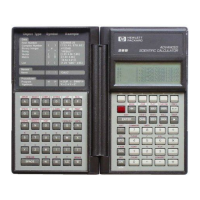Stack Memory. A
dynamic
stack
has
the
advantage
that
you
can
use
as
many
levels as you
need
for
any
calculation,
without
worrying
about
losing objects
Hoff
the
top" as you
enter
new
ones. This also
has
the
disadvantage
that
you
can
tie
up
a significant
amount
of
memory
with
old objects, if you leave
them
on
the
stack after you are finished
with
a calculation. With
the
HP-28S, you
should
get in
the
habit
of
discarding
unneeded
objects from
the
stack.
DROP Versus CLX.
In
fixed-stack calculators,
CLX
means
Hreplace
the
contents
of
the
X-register
with
0,
and
disable stack
liW
(see
be-
low). Its
primary
purpose
is to
throwaway
an
old
number, prior to
replacing it
with
a
new
one-but
you
can
also use it as a
means
to
enter
O.
On
the
HP-28S,
CLX
is replaced
by
DROP,
which
does
what
its
name
implies-it
drops
the
object in level 1 from
the
stack,
and
the
rest
of
the
stack
drops
down
to fill in.
No
extraneous 0 is entered.
Similarly, CLEAR
drops
all objects from
the
stack,
instead
of
replacing
them
with
zeros as does its fixed-stack
counterpart
CLST (CLEAR
STACK).
Stack-Lift
Disable and ENTER
Certain
commands
on
fixed-stack calculators (ENTER
t,
CLX,
~
+,
~
-)
exhibit a peculiar feature called stack-lift
disable.
That
is, after
any
of these
commands
is executed,
the
next
number
entered
onto
the
stack replaces
the
current
contents
of
the
X-register,
rather
than
push-
ing it into
the
Y -register. This feature is entirely
absent
on
the
HP-
28S.
New
objects
entered
onto
the
stack always
push
the
previous
stack objects
up
to
higher
levels.
The X-register
and
ENTER
on
fixed-stack calculators
play
dual
roles
that
are derived
more
from
the
single-line display
of
the
calculators
than
from
the
stack structure.
The
X-register acts as
an
input
register
as well as
an
ordinary
stack
register-when
you key
in
a number,
the
digits are created
in
the
X-register,
until
a
non-digit
key
terminates
entry. The I
ENTERt
I key is
provided
for
separating
two consecutive
number
entries. But in
addition
to
terminating
digit entry,
the
I
ENTERt
I key also copies
the
contents
of
the
X-register
into
Y,
and
dis-
ables stack lift.
298
B:
Notes
for
HP
RPN
Calculator
Users

